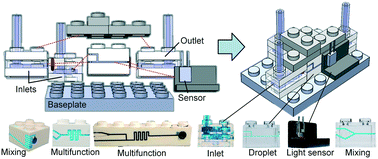Lab on a Brick: Microfluidics with Modular Units
Any two LEGO bricks in the world will fit together precisely. Using this principle, LEGO bricks were modified to transport fluid in precise ways, snapping together to form different circuits. Please don't hesitate to contact us if you would like to discuss my work in more detail.
This was done with the Mechanosynthesis Lab Group within the Laboratory for Manufacturing and Productivity in the Department of Mechanical Engineering at the Massachusetts Institute of Technology.
The Idea
Any two LEGO bricks in the world will fit together precisely, due to their manufacturing quality and the way they were designed.
Using this principle, store-bought LEGO bricks were modified to transport fluid in precise ways, snapping together to form different circuits for microfluidics, or fluids handled at small, micro-scales. At small dimensions, below a mm, viscous forces overwhelm inertia, and fluid doesn't swirl and slosh the same way as when in a large container, like a bucket. Using this enhanced control at small scales, microfluidics is used for biological applications, blood tests, diagnostics, water quality testing, and chemical and biology research, among other things. Though it seems simple, the way that these blocks fit together is very important to ensure the entire system functions appropriately, making the injection-molded LEGO bricks more suitable than even 3D-printed pieces.For more information
This article is free to access until 28 February 2018. C E Owens and A J Hart, Lab Chip, 2018, DOI: 10.1039/c7lc00951h: http://pubs.rsc.org/en/content/articlehtml/2017/lc/c7lc00951h
MIT News: http://news.mit.edu/2018/microfluidics-lego-bricks-0131
Chemistry World: https://www.chemistryworld.com/news/lego-brick-microfluidics/3008517.article
More Assembly Details
Blocks can be placed in a linear chain, as above, to do operations on pieces of fluid flowing through. They can also be combined to mix fluids in more complicated systems, for controlling the reaction of two fluids.
How they are made
A micromill etches patterns into the sidewall of bricks, which are sealed over using a piece of sealing film. O-rings between bricks allow fluid to flow between adjacent bricks without leaking.
